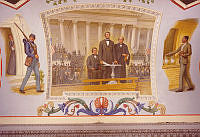Rubenstein Center Scholarship
William Costin
This article is part of the Slavery in the President’s Neighborhood initiative. Explore the Timeline
After Washington, D.C. was established as the nation’s capital, Black people found themselves in a precarious position. While some individuals entered the city as enslaved labor for the white elite, there was also a rapidly growing free Black population. This community continued to expand as many enslaved people were manumitted by their enslavers and other free Black people migrated to the city from the surrounding areas in search of greater economic opportunities. As the free Black population soared, the local government passed and enforced laws designed to suppress this growth by restricting the freedoms of African Americans. They hoped these laws would stifle the growing free Black population, but they did not expect the pushback from leaders of the free Black community like William Custis Costin, a free person of color who notably fought against these restrictive measures.
Born sometime in 1780, William Custis Costin was the son of Ann Dandridge, a woman of mixed Indigenous, Black, and white ancestry, and a white man belonging to “a prominent family in Virginia.”1 Costin was allegedly both the nephew and grandson of Martha Washington. His mother may have been the first lady’s half-sister, Ann Dandridge, and his father was allegedly Martha’s son, John Parke Custis.2 Despite his mother’s enslaved status, Costin was born free, never appearing on any slave registries at Mount Vernon, and possibly lived on the plantation with his mother and enslaved younger sisters.3 Click here to learn more about the enslaved households of President George Washington.

William Costin live and worked in Washington, D.C. for many years, becoming a prominent member of the free Black community.
Library of CongressFor a number of reasons, there are some doubts surrounding the nature of these relationships. Some of this uncertainty stems from the lack of documentation of both Ann Dandridge and Costin in Mount Vernon’s records. Beyond the descendant oral histories received by Mount Vernon in the 1960s, there is no known record acknowledging the presence of either Dandridge or Costin at Mount Vernon. The lack of records in slave listings and state tax payments is out of the ordinary as Dandridge was legally enslaved until her manumission in the early nineteenth century and Costin was believed to have lived his entire life as a free person.4
Dandridge, believed to be the mixed-race child of John Dandridge, Martha Washington’s father, and a Black and Indigenous woman, was not mentioned as living or working at Mount Vernon at any point. This silence has led many historians to question how the first lady’s half-sister was left out of the meticulous records at Mount Vernon, as George Washington and his plantation managers were thorough note keepers.5 However, this absence is peculiar as Dandridge and her younger children were eventually enslaved and manumitted by Martha Washington’s granddaughter and grandson-in-law, Eliza Custis Law and Thomas Law. The Laws acquired a number of enslaved people from Eliza’s grandparents by 1802, making it a possibility that Dandridge and her children were enslaved at Mount Vernon and were passed down to Eliza and Thomas at some point.6
Even more perplexing is the complete absence of Costin from Mount Vernon’s records and how he acquired his free status. Given the enslaved status of his mother and six younger sisters, and the legal requirement that a Black child take the status of the mother, it would be plausible to assume that Costin would have been enslaved.7 However, there is nothing in Mount Vernon’s records indicating Costin’s presence there during his lifetime, something particularly odd given George Washington’s extremely detailed records, nor is there any documentation regarding his lifelong free status.8 One potential explanation is that Martha had some sympathy for Costin and granted him his freedom, as her father-in-law, John Custis, notably did for his Black son, Jack.9 It is possible that she may have allowed Costin the privilege of living as a free person due to the familial ties. It is also possible that she may have kept Costin out of Mount Vernon’s records to protect her husband from any publicly acknowledged ties to Black relatives or any scandal considering the fact that Costin may have been born of an incestuous act between her son and half-sister.10

First Lady Martha Washington was believed to be the aunt and grandmother of William Costin. Costin's mother, Ann Dandridge, was alleged to be the First Lady's half-sister. It was also alleged that her son, John Parke Custis, was Costin's father.
White House Collection/White House Historical AssociationAnother reason some historians doubt the relationship between Costin, Dandridge, and Martha Washington is the assumed age of Ann Dandridge. Dandridge and the first lady reportedly “grew up together”, leading to the presumption that the women were fairly close in age.11 This would place Dandridge in her late forties or early fifties at the time of Costin’s birth in 1780, in comparison to John Parke Custis, Costin’s alleged father, who was twenty-six at the time. This proximity in age would also place Dandridge in or near her sixties and seventies during the births of her six daughters from 1788 through 1801.12 Because of this age discrepancy, some scholars speculate that the history of Ann Dandridge may be the combined lives and stories of two different women, perhaps a mother and daughter.13
Another possible explanation is that Dandridge was born many years after Martha. There is no actual known date of birth for Ann, but she likely was born sometime between Martha’s birth in 1731 and her father John Dandridge’s death in 1756. Records also indicate that Martha brought a number of enslaved people from her first husband’s estate to Mount Vernon upon her marriage to George Washington. It has been speculated that a young girl, possibly Ann Dandridge, who was a playmate of the first lady’s children and was often referred to as a “child of the plantation” and a “little colored pet” was one of the enslaved people that joined Martha.14 This evidence would place Ann Dandridge closer in age to the alleged father of Costin at the time of his birth in 1780, making it more plausible that she could birth an additional six children who lived past infancy.15
Costin eventually left Virginia and moved to the District, where he married Philadelphia “Delphy” Judge.16 Delphy, the enslaved sister of Oney “Ona” Judge, was owned by Thomas Law and Eliza Custis Law, the granddaughter and grandson-in-law of Martha Washington. In place of Ona, who had escaped bondage at Mount Vernon, Delphy was at some point given to the Laws by the first lady to help the newly married and expecting Eliza.17 Delphy and her two daughters, Louisa and Ann, were manumitted by Thomas Law on June 13, 1807.18
[T]he constitution knows no distinction of color. That all who are not slaves are equally free; that they are . . . equally citizens of the United States." He also believed that people of color had “a right to come here and claim all the privileges of citizenship.
Costin provided for his newly freed family by working twenty-four years as a messenger for the Bank of Washington. Costin also used his relatively privileged position to help others in the enslaved community. Throughout the 1820s, Costin purchased and emancipated at least ten enslaved people, including his own family members and individuals connected to Mount Vernon. Costin also bought a home for his family on A Street Northeast near Capitol Hill and offered shelter to anyone in need.19 As a well-respected member of the Washington, D.C. community, Costin was a natural leader to advocate for the District’s free Black community.
In 1820, the D.C. City Council passed a law that effectively required all free people of color to file for a permit to continue to live within the city’s limits. In addition, the law required free people of color to appear before the city’s mayor with “the papers of freedom or other evidence of freedom” and “a statement of his, her, or their trade or occupation and means of subsistence.” Free people of color were also required to have certificates from three “respectable” white people they knew personally in their neighborhood who could confirm they lived “peaceable and quiet lives,” verify their occupations, and whether they were unlikely to become wards of the city. If free African Americans violated these provisions, they were subject to a fine, imprisonment, and possible removal from the city.20
In response to the law, William Costin intentionally refused to appear before the mayor with the required documents, daring the city’s officials to enforce the consequences. After the city levied a fine against him, Costin sued the District, arguing that the law violated the city’s charter and the U.S. Constitution by attempting to regulate how free people of color resided in the city. Costin argued that: "[T]he constitution knows no distinction of color. That all who are not slaves are equally free; that they are . . . equally citizens of the United States." He also believed that people of color had “a right to come here and claim all the privileges of citizenship.”21
The case eventually made its way to the United States Circuit Court of the District of Columbia where Chief Judge William Cranch provided the final decision for the case. In Costin v. Washington, Chief Judge Cranch ruled that the city’s authority from Congress to regulate these issues did not conflict with the city’s charter or the Constitution. However, he did reverse the punishment against Costin, stating that the law “must be construed prospectively, and not retrospectively,” and therefore should not be applied to Costin and other free people of color who resided in the District before the law was enacted. Cranch also stated “[t]hat it could not reasonably be supposed to be the intention of congress to banish old and long-established inhabitants of the city who have acquired real estates therein, whose lives have been unexceptionable, who can neither be reproached for, nor suspected of any crime.”22

Chief Judge William Cranch issued the ruling in Costin v. Washington. He ruled that the city had the right to deny some of its citizens the rights enjoyed by others.
Library of CongressWhile the ruling was a victory for Costin, it was still a setback for free people of color who hoped to move into the city in the future. Chief Judge Cranch explained that while the Constitution does provide equal rights to all of the citizens of the United States, “that clause of the constitution does not prohibit any state from denying to some of its citizens some of the political rights enjoyed by others.”23 Chief Judge Cranch also stated that:
Every state has the right to pass laws to preserve the peace and the morals of society; and if there be a class of people more likely than others to disturb the public peace, or corrupt the public morals, and if that class can be clearly designated, it has a right to impose upon that class, such reasonable terms and conditions of residence, as will guard the state from the evils which it has reason to apprehend.24
This rationalization further solidified the message that the District excluded and did not value free people of color.
After gaining legal reprieve in the Costin v. Washington ruling, Costin continued to work as a messenger at the Bank of Washington, maintained a close business relationship with the grandchildren of Martha Washington, and supported the free Black community. There are records of the Custis grandchildren’s correspondence throughout the early nineteenth century mentioning Costin and some business transactions between them related to Costin’s hack business. Costin’s position at the Bank of Washington also provided an opportunity for the Custis grandchildren to have access to borrowing money when necessary with Costin possibly serving as a messenger for his relatives.25 In 1823, his daughter, Louisa, opened a school for Black people in her father’s home. After Louisa and her mother, Delphy, passed away in 1831, Louisa’s sister, Martha, ran the school until 1839. On June 6, 1838, William Costin remarried Elizabeth Matthews, remaining married until his unexpected passing in his sleep on May 31, 1842.26
Upon his death, former President John Quincy Adams said, “[t]he late William Costin, though he was not white, was as much respected as any man in the District, and the large concourse of citizens that attended his remains to the grave, as well white as Black, was an evidence of the manner in which he was estimated by the citizens of Washington.”27Click here to learn more about the enslaved households of President John Quincy Adams.The Board of Directors at the Bank of Washington passed a resolution in Costin’s honor and gifted his family fifty dollars.28 In his obituary, the Daily National Intelligencer noted that “the citizens of Washington generally bear testimony to his excellent qualities,” showing how strong of an impact Costin had on his community.29 William Costin’s dedication to his community left a remarkable legacy that aided in the push for equal treatment of the free Black community in the District.
Thank you to Mary V. Thompson, author of "The Only Avoidable Subject of Regret:" George Washington, Slavery, and the Enslaved Community at Monticello, for sharing her research and insight into the life of William Costin.





